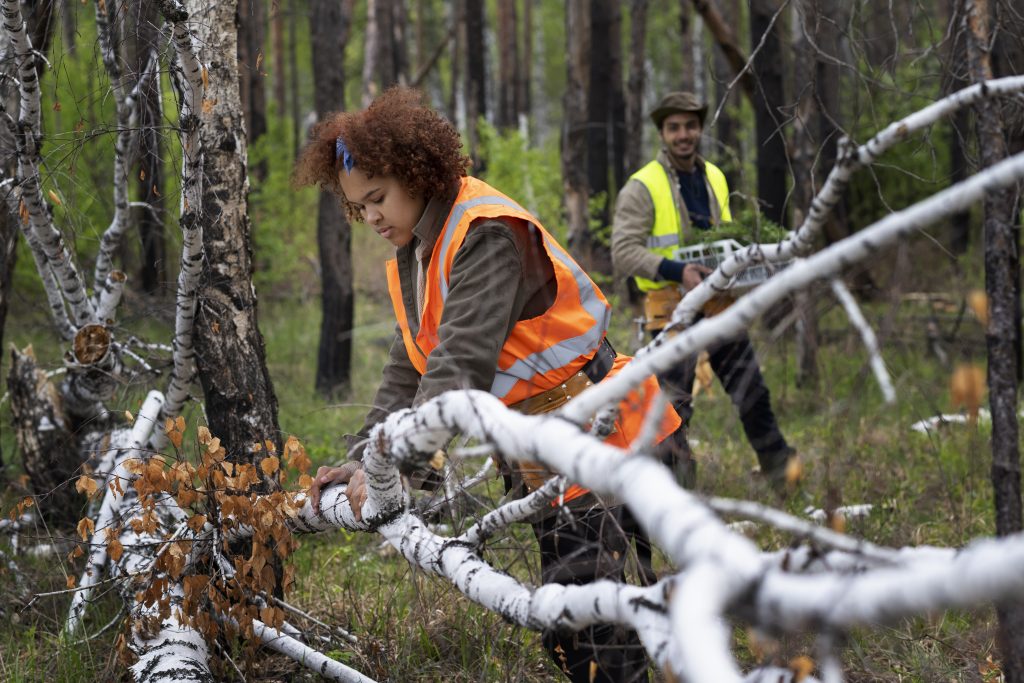How to Check License for a Tree Service Company?
How to Check License for a Tree Service Company: Ensuring a Legitimate and Professional Business

When it comes to hiring a tree service company, ensuring that they are properly licensed and insured is of utmost importance. Licensed tree service companies adhere to local regulations, possess the necessary expertise, and offer liability coverage, ensuring a safe and professional service. This comprehensive guide will walk you through the essential steps to verify the license of a tree service company, whether it operates in Utah, specifically in Murray, or in any other state. We will also explore the significance of insurance, regulations, legal documents, and other vital aspects of running a legitimate tree service business.
Researching Local Licensing Requirements:
Before hiring any tree service company, it is essential to understand the licensing requirements in your state or city. Each state may have its own set of rules and regulations for tree service providers. In Utah, for instance, tree service companies need to comply with the Contractors State License Board (CSLB) regulations. Research your state’s laws and regulations governing tree care businesses, including the required licenses and permits.
Verifying License and Registration:
Once you have identified a tree service company, verify its license and registration status. You can check this information by contacting the relevant state or local authority. For example, in California, you can use the CSLB website to search for the license number, business name, or contractor’s name to view the registration status and other details. Ensure that the license is valid, up-to-date, and specific to tree services.
Checking Insurance Policies:
In addition to a valid license, a tree service company should have appropriate insurance coverage. This is essential to protect both the company and the property owners in case of accidents or property damage during tree work. Ask the company for proof of general liability insurance and worker’s compensation coverage. Verify the policies with the insurance companies to ensure they are valid and provide adequate protection.
Evaluating Experience and Years in Business:
Experience is a crucial factor when it comes to hiring a reliable tree service company. Look for companies that have been in the business for several years as it indicates their expertise and ability to handle various tree care tasks. A company with a long track record is likely to have encountered and successfully addressed a wide range of challenges.
Checking Customer Reviews and References:
Gather feedback from past customers to assess the tree service company’s performance. Online reviews and testimonials can provide valuable insights into the quality of their work, customer service, and reliability. Additionally, ask the company for references from recent customers and contact them to inquire about their experiences. Positive feedback from satisfied customers is a good indicator of a reputable tree service provider.
Understanding State and Federal Taxes:
As a tree service company, understanding and complying with state and federal tax regulations is crucial. Ensure the company is registered for an Employer Identification Number (EIN) and complies with all tax obligations. It is recommended to consult with an accountant or tax professional to ensure compliance with tax laws and to avoid any potential tax-related issues.
Types of Insurance Coverage:
Tree service businesses should have various types of insurance coverage to safeguard their operations and protect customers. Some common types of insurance coverage include:
a. General Liability Insurance: Covers property damage and bodily injury claims arising from tree care services.
b. Worker’s Compensation Insurance: Provides coverage for employee injuries or illnesses that may occur while on the job.
c. Equipment Insurance: Covers the replacement or repair of equipment used in tree care operations.
d. Business Owner’s Policy (BOP): A bundled insurance policy that includes general liability and property insurance.
Understanding Local Tree Care Regulations:
Complying with local tree care regulations is vital to run a legitimate tree service business. Understand the specific laws regarding tree trimming, removal, and other tree care practices in your area. This ensures that the services provided are legal and do not harm the environment or violate any conservation laws.
Legal Documents and Contracts:
When hiring a tree service company, ensure that you receive written contracts and agreements outlining the scope of work, timelines, costs, and other essential details. Legitimate tree service providers should be willing to provide transparent and legally binding documents.
Recognizing Emergency Services:
In addition to routine tree care, some companies also offer emergency tree services. Verify that the tree service company you are considering provides such services and has the capacity to respond promptly to emergency situations.
Small Businesses and Startup Considerations:
If you are starting a tree service business, consider legal aspects such as business structure (e.g., sole proprietorship, partnership, LLC, corporation), registration with the appropriate authorities, and obtaining necessary permits and licenses. Additionally, explore mentorship opportunities, seek legal counsel for legal services, and familiarize yourself with the required insurance policies and types of equipment needed for efficient tree care.
Evaluating Criminal History and Background Checks:
For the safety and peace of mind of both the tree service company and their customers, background checks on employees and founders are crucial. Ensure that the company performs comprehensive background checks, including criminal records, to ensure the credibility of their staff.
Conclusion:
Checking the license of a tree service company is a fundamental step in ensuring that you are hiring a legitimate, experienced, and insured service provider. By verifying licenses, insurance policies, customer reviews, and adhering to local regulations, you can make an informed decision and avoid potential risks or liabilities. Whether you are a property owner seeking tree care services or an entrepreneur starting a tree service business, being well-informed about legal requirements, taxes, and insurance coverage is essential for a successful and reputable venture. Always prioritize safety, compliance, and professionalism when selecting a tree service company.
About Murray, Utah
Murray is a city situated on the Wasatch Front in the core of Salt Lake Valley in the U.S. state of Utah. Named for territorial governor Eli Murray, it is the state's fourteenth largest city. According to the 2020 census, Murray had a population of 50,637. Murray shares borders with Taylorsville, Holladay, South Salt Lake and West Jordan, Utah. Once teeming with heavy industry, Murray's industrial sector now has little trace and has been replaced by major mercantile sectors. Known for its central location in Salt Lake County, Murray has been called the Hub of Salt Lake County. Unlike most of its neighboring communities, Murray operates its own police, fire, power, water, library, and parks and recreation departments and has its own school district. While maintaining many of its own services, Murray has one of the lowest city tax rates in the state.
Neighborhoods in Murray, Utah
Murray Oakes, Grant Park, Southwood Park, Murray Park, Murray Park Restrooms, Willow Pond Park, Neighborhood Veterinary Care
Things To Do in Murray, Utah
Bus Stops in Murray, Utah to Truco Services, Inc.
Bus Stop in Murray Central Station (Bay C) Murray, Utah to Truco Services, Inc.
Bus Stop in State St @ 4801 S Murray, Utah to Truco Services, Inc.
Bus Stop in Murray North Station Murray, Utah to Truco Services, Inc.
Bus Stop in State St @ 4949 S Murray, Utah to Truco Services, Inc.
Bus Stop in Murray Central Frontrunner/Trax Station Murray, Utah to Truco Services, Inc.
Bus Stop in Murray Blvd / Vine St (SB) Murray, Utah to Truco Services, Inc.
Bus Stop in State St @ 3925 S Murray, Utah to Truco Services, Inc.
Bus Stop in State St @ 4824 S Murray, Utah to Truco Services, Inc.
Bus Stop in State St @ 5223 S Murray, Utah to Truco Services, Inc.
Bus Stop in Murray Blvd / Allendale Dr (NB) Murray, Utah to Truco Services, Inc.
Bus Stop in Murray Blvd @ 5039 S Murray, Utah to Truco Services, Inc.
Bus Stop in State St @ 4721 S Murray, Utah to Truco Services, Inc.
Driving Directions in Murray, Utah to Truco Services, Inc.
Driving Directions from Woodruff Tree Trimming and Removal to 4640 Commerce Dr, Murray, UT 84107, USA
Driving Directions from Reliable Tree Care to 4640 Commerce Dr, Murray, UT 84107, USA
Driving Directions from Tree Pro-Tech to 4640 Commerce Dr, Murray, UT 84107, USA
Driving Directions from Prestige Tree And Landscape to 4640 Commerce Dr, Murray, UT 84107, USA
Driving Directions from Excellence Tree & Landscape to 4640 Commerce Dr, Murray, UT 84107, USA
Driving Directions from Amen Trees to 4640 Commerce Dr, Murray, UT 84107, USA
Driving Directions from Tim's Tree Care to 4640 Commerce Dr, Murray, UT 84107, USA
Driving Directions from Jordan Tree Service - Murray to 4640 Commerce Dr, Murray, UT 84107, USA
Driving Directions from Arbor Works to 4640 Commerce Dr, Murray, UT 84107, USA
Driving Directions from Diamond Tree Experts to 4640 Commerce Dr, Murray, UT 84107, USA
Driving Directions from Green Tree Arborist to 4640 Commerce Dr, Murray, UT 84107, USA
Driving Directions from TruCo Services to 4640 Commerce Dr, Murray, UT 84107, USA
Reviews for Truco Services, Inc. Murray, Utah
Emily Abercrombie
We had a great experience with TruCo! They were well priced, responsive and prompt. Michael was a pleasure to work with and gave us advice on which plants to put in where we took out our ugly old shrubs. I would highly recommend this company!!!
Michelle Turpin
TruCo Services gets 5 stars from us for customer service. We experienced a few issues with their services this last year and Rob Eccles in senior management, stepped in and immediately handled our issues. He was very committed to making sure they understood our expectations and would execute to make us happy.
Siobhan Billingsley
I work for a property management company and have the pleasure of working with Rob at a community in Sandy. He has been incredible to work with and always responds in a timely manner. He knows all the homeowners by name and address and is aware of all the "problem" areas when it comes to sprinklers. I never have to worry about following up with him because he always reaches out to provide me with an update. If you're looking to work with someone who takes pride in their job, is professional, and can solve the worst landscaping problems thrown your way, Rob is your guy. Thank you, Rob for all you do!
Jaime S.
We have used Truco at 2 of the complexes we manage, they have been great to work with. Good quality service, outstanding customer service with good communication. That's hard to find these days. I highly recommend them. Travis has been awesome to work with.
Jerusha Smart
We use TruCo for a majority of our properties and our home. While other landscaping companies we use come and go for various reasons like cost, communication issues, work performance, etc., TruCo is always consistent in price and work. Also, Rob is the best.
